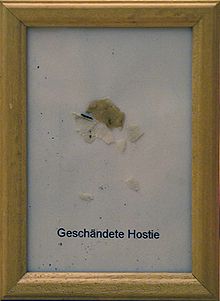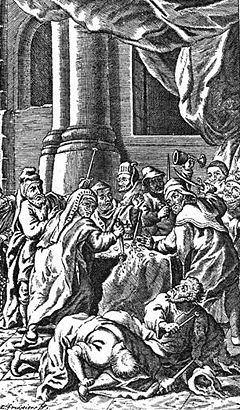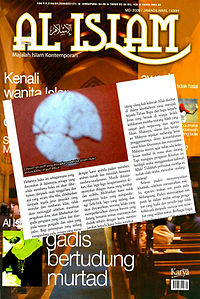- Host desecration
-
Host desecration is a form of sacrilege in Christianity (most frequently identified as such in the traditions of Anglicanism, Eastern and Oriental Orthodoxy, Lutheranism, and Roman Catholicism) involving the mistreatment or malicious use of a consecrated host— the sacred bread used in the Eucharistic service or Mass. In Roman Catholicism, where the host is held to have become the body of Jesus Christ, host desecration is among the gravest of sins. Intentional host desecration is not only a mortal sin but also incurs the penalty of excommunication latae sententiae. Throughout history, a number of groups have been accused of desecrating the Eucharist, often with grave consequences due to the spiritual importance of the consecrated bread.
Contents
Overview
Accusations against Jews were a common pretext for massacres and expulsions throughout the Middle Ages in Europe.[1] Similar accusations were made in witchcraft trials; witch-hunter's guides such as the Malleus Maleficarum refer to hosts as being objects of desecration by witches.[2] It is part of many descriptions of the Black Mass, both in ostensibly historical works and in fiction.[3]
Background
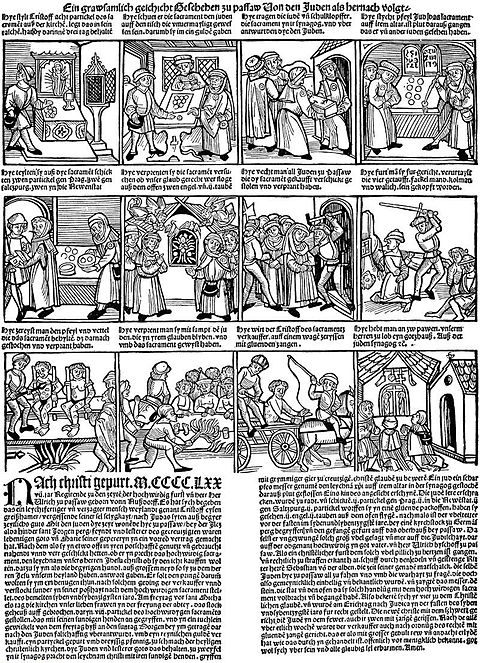 From a 15th-century German woodcut of the supposed host desecration by the Jews of Passau, 1477. The hosts are stolen and pierced in a Jewish ritual; they are recovered and shown to be holy. The guilty Jews are arrested, beheaded, and tortured with hot pincers; the entire community is driven out with their feet bound and held to the fire. At the end the Christians kneel and pray.
From a 15th-century German woodcut of the supposed host desecration by the Jews of Passau, 1477. The hosts are stolen and pierced in a Jewish ritual; they are recovered and shown to be holy. The guilty Jews are arrested, beheaded, and tortured with hot pincers; the entire community is driven out with their feet bound and held to the fire. At the end the Christians kneel and pray.
The Catholic Church, along with the Orthodox churches and some Anglican churches, believes that during the celebration of the Eucharist, the offerings of bread and wine are changed in substance into the body and blood of Jesus, while still maintaining all the physical (or in sacramental terms, accidental) properties of bread and wine. While the Real Presence of Christ in the Eucharist was believed from the earliest days of the Church[4], during the Middle Ages Catholic theology offered the concept of transubstantiation to explain this change of substance which was believed to be actual and not merely symbolic. The concept, defined as a dogma at the Fourth Lateran Council of 1215, holds that the substances of the offerings are literally transformed, while the appearance of bread and wine remain.
Christians believe Jesus to be "true God and true man." In the Catholic Church, therefore, his "body" and "blood" in the form of the consecrated host are adored. Theft, sale, or use of the host for a profane purpose is considered a grave sin and sacrilege,[5] which incurs the penalty of excommunication, which is imposed automatically in the Latin Rite (See Code of Canon Law, Latin Rite Code canon 1367, or Eastern Rite Code canon 1442.) It is widely believed among Roman Catholics that, under certain circumstances such as disbelief or desecration, the host could display supernatural properties.
Some Protestant denominations, especially Lutherans, have similar beliefs regarding the Eucharist and the Real Presence, though they differ about the rite and reject the concept of transubstantiation which Catholics and Orthodox Eastern Christians hold to.
Host desecration has been associated with groups identified as inimical to Christianity. It is a common belief that desecration of the host is part of Satanic practice, especially the Black Mass. LaVeyan Satanists do not typically perform Black Mass as a regular ritual, though "Le Messe Noir" from Anton LaVey's work The Satanic Rituals does include some elements.
Since the publication of a document called Memoriale Domini in 1969,[6] the Apolistic See of the Catholic Church has allowed certain countries to allow communicants to receive the Host in the hand, rather than directly onto the tongue, reviving an "ancient custom".[6] Communion in the hand is now widespread in many parts of the world. The practice means that access to consecrated Hosts is easier than in the past, since the person receiving it in the hand may pretend to place it in their mouth for consumption. However, recent statements and practices of Pope Benedict XVI[citation needed] have caused a recent shift in Catholic practice (notably at Papal Masses and amongst more traditional-minded Catholics) of receiving on the tongue while kneeling, which is also an ancient practice. (This practice was still performed commonly and consistently, even as recently as the early 1970s in America, and is still received orally in many churches and countries presently. Receiving on the tongue is still the official norm of the Catholic Church, while receiving in the hand [via the Memoriale Domini indult] is, in English-speaking countries, the practical norm.)
Medieval accusations against Jews
Antisemitism 
History · Timeline · Resources Deicide · Blood libel
Well poisoning · Host desecration
Jewish lobby · Jewish Bolshevism
Kosher tax · Dreyfus affair
Zionist Occupation Government
Holocaust denialOppositionCategoriesFalse accusations of "host desecration" leveled against Jews were a common pretext for massacres and expulsions throughout the Middle Ages in Europe.[1] The libel of "Jewish deicide": that the Jewish people were responsible for the killing of Jesus, whom Christians regard as God become man, was a generally accepted Christian belief. It was falsely claimed that Jews stole hosts, objects to which they attached no significance, religious or otherwise, and abused these hosts purportedly, according to these false accusations, to re-enact the crucifixion of Jesus by stabbing or burning them. These accusations attributed Roman Catholic beliefs onto Jews who completely reject the belief that God can exist in the host; and who attach no significance to the host; thus making the concept of its "descration" obviously absurd.
It has been asserted by modern scholars, such as the Catholic priest Gavin Langmuir, that these false accusations against Jews represented profound doubt about the truth of Christianity. Catholics were being told, in the so-called transubstantiation doctrine, that they, by consuming the host, were eating human flesh and drinking human blood. To dispel their doubts about transubstantiation, Christians projected a system of belief onto Jews that was completely alien to Judaism and Jewish law where strict dietary laws forbid the consumption of blood; even when consuming kosher animals.
Jews in the Middle Ages were frequently victims of similar accusations, considered more serious desecration of other revered items, such as relics or images of Jesus and the saints. The accusations were often supported only by the testimony of the accuser, who may potentially bear a prejudice against the accused Jew or the Jewish people. Despite this, some alleged perpetrators were tried and found guilty, on little evidence or through torture.[1]
The penalties for Jews accused of defiling hosts were severe. Many Jews, after false accusations and torture, "confessed" to abusing hosts, and the accused Jews were condemned and burned, sometimes with all the other Jews in the community, as happened in Berlitz in 1243.[7] in Prague in 1389,[8] and in many German cities, according to Ocker's writings in the Harvard Theological Review. According to William Nichol in Christian Antisemitism, "over 100 instances of the charge have been recorded, in many cases leading to massacres."
The first recorded accusation was made in 1243 at Berlitz, near Berlin. As a consequence all the Jews of Berlitz were burned on the spot, which was subsequently called Judenberg. Another famous case that took place in 1290, in Paris, was commemorated in the Church of the Rue des Billettes and in a local confraternity. In 1370 in Brussels, the charge of host desecration, long celebrated in a special fest and depicted in artistic relics in the Church of St. Gudule, led to the extermination of the Jews of the city. The case of 1337, at Deggendorf, still celebrated locally as "Deggendorf Gnad", led to a series of massacres across the region. In 1510, at Knoblauch, near Berlin, 38 Jews were executed and more expelled from Brandenburg.
The alleged host desecration in 1410, at Segovia, was said to have brought about an earthquake, and as a result, the local synagogue was confiscated and leading Jews were executed; the event continues to be celebrated as a local feast of Corpus Christi. Similar accusations, resulting in extensive persecution of Jews, were brought forward in 1294, at Laa, Austria; 1298, at Röttingen, near Würzburg, and at Korneuburg, near Vienna; 1299, at Ratisbon; 1306, at St. Pölten; 1330, at Güstrow; 1338, at Pulkau; 1388, at Prague; 1401, at Glogau; 1420, at Ems; 1453, at Breslau; 1478, at Passau; 1492, at Sternberg, in Mecklenburg-Schwerin; 1514, at Mittelberg, in Alsace; 1556, at Sochaczew, in Poland. The last Jew burned for stealing a host died in 1631, according to Jacques Basnage, quoting from Manasseh b. Israel. In some cases host desecration legends emerged without actual accusations, as was the case of the host desecration legend of Poznan (Posen).[9]
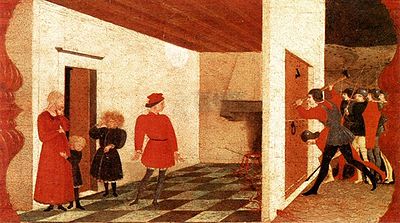 The second panel of Paolo Uccello's Miracle of the Profaned Host from the Urbino Confraternity of Corpus Domini predella. A Jewish moneylender is cooking the host, which emanates blood. The Jew's wife, her unborn child, and her children look on in terror as the blood pours into the street in rivers while soldiers break through the door. The painting is structured around the Golden Section. Dated: 1467-1469.
The second panel of Paolo Uccello's Miracle of the Profaned Host from the Urbino Confraternity of Corpus Domini predella. A Jewish moneylender is cooking the host, which emanates blood. The Jew's wife, her unborn child, and her children look on in terror as the blood pours into the street in rivers while soldiers break through the door. The painting is structured around the Golden Section. Dated: 1467-1469.
The accusation of host desecration gradually ceased after the Reformation when first Martin Luther in 1523 and then Sigismund August of Poland in 1558 were among those who repudiated the accusation. However, sporadic instances of host desecration libel occurred even in the 18th and 19th century. In 1761 in Nancy, several Jews from Alsace were executed on a charge of host desecration. The last recorded accusation was brought up in Bislad, Romania, in 1836.[1]
2008 controversy in the US
In his July 8 blog entry, University of Minnesota Morris biology professor PZ Myers criticized the reaction to a local student's perceived act of host desecration (the student had attempted to bring the host to a friend who was curious about communion). Myers described the level of harassment against the student and expressed his intent to desecrate the wafer, which Catholics consider a mortal sin.[10]
Myers expressed outrage that Fox News appeared to be inciting readers to cause further problems for the student, and ridiculed reports that armed guards would attend the next Mass. Myers suggested that if any of his readers could acquire some consecrated Eucharistic hosts for him, he would treat the wafers "with profound disrespect and heinous cracker abuse, all photographed and presented here on the web."[11]
A number of Catholics immediately reacted strongly. William A. Donohue of The Catholic League accused Myers of anti-catholic bigotry,[12] described his proposal as a threat to desecrate what Catholics hold to be the Body of Christ, and sent a letter asking the University of Minnesota and the Minnesota State Legislature to take action against Myers.[12][13]
According to Donohue, as the Pharyngula website was accessible via a link from the University of Minnesota website, it should be bound by the institution's code of conduct which requires faculty to be "respectful, fair and civil" when dealing with others.[13] Subsequently, Myers explained to the Star Tribune that while his post was "satire and protest", he had received death threats regarding the incident but was not taking them too seriously.[12]
Al-Islam magazine
In 2009, two Muslim reporters from Al-Islam, a small Malaysian magazine, participated in a Catholic Mass and received Holy Communion, which they then spat out and photographed. The resulting photo was then published in their May 2009 edition.[14] The magazine, which is owned by Utusan Karya, part of the Utusan Malaysia Group, sent its reporters including one Muhd Ridwan Abdul Jalil, to two churches in the Klang Valley, as part of a special investigative report.[14] The act of desecration occurred at St Anthony's Church in Jalan Robertson, Kuala Lumpur.[15]
After its publication, two lay Catholics from Penang, Sudhagaran Stanley and Joachim Francis Xavier, jointly lodged a police report against the reporters.[16] The police took no action despite a potential charge under Section 298A (1) of the Penal Code for causing disharmony, disunity or feelings of enmity, hatred or ill will, or prejudicing the maintenance of harmony or unity, on grounds of religion.[14]
The desecration caused widespread outrage and condemnation from non-Muslims as well as Muslims[17] across the country. Parties including the Archbishop of Kuala Lumpur, Murphy Pakiam; the Catholic Lawyers Society; as well as numerous editorials in the media,[14] criticised the government and the Attorney-General for its failure to act.[18][19][20] Many saw this inaction as a case of the government's double standards, when dealing with religious issues.
Some nine months later, in early March 2010, Al-Islam published an apology to the Catholic Church and other Christians for the article. It was posted on the website of its publisher.[21] Archbishop Pakiam, who is also president of the Catholic Bishops’ Conference of Malaysia, Singapore and Brunei, accepted the apology and said that no further (legal) action would be taken.[22] The journalist and his colleague have personally never made any public statements on the matter nor apologised.
See also
References
- ^ a b c d "Desecration of the Host", Jewish Encyclopedia, retrieved 7 May 2007
- ^ Summers, Montague, ed. The Malleus Maleficarum of Kramer and Sprenger, 1948. Originally in Latin, Germany, 1487. eg. Part II, Question I, Chapter IV:"...they are bound to observe certain other abominable ceremonies at the command of the devils, such as to spit on the ground at the Elevation of the Host."
- ^ See the studies by: Rhodes, H.T.F. The Satanic Mass, 1954 and Zacharias, Gerhard The Satanic Cult, 1980.
- ^ "Catholic Answers - The Real Presence (Fathers)", retrieved 15 May 2011
- ^ "Sacrilege", Catholic Encyclopedia, 1912, retrieved 7 May 2007
- ^ a b "Memoriale Domini", retrieved 7 May 2007
- ^ "The History of the Jewish People", Berlitz 1843, retrieved 7 May 2007
- ^ "Blood libel accusations against Jews", Religious Tolerance Organisation, retrieved 7 May 2007. [1]
- ^ Magda Teter (2011). Sinners on Trial: Jews and Sacrilege after the Reformation. Harvard University Press. ISBN 9780674052970.
- ^ "Student Who Took Religious Icon Getting Death Threats". MY Fox Orlando. 2008-07-07. http://www.myfoxorlando.com/myfox/pages/Home/Detail;jsessionid=912931E6387D06E86603288C86CA66A1?contentId=6932236&version=2&locale=EN-US&layoutCode=TSTY&pageId=1.1.1&sflg=1. Retrieved 2008-07-11.
- ^ "IT'S A FRACKIN’ CRACKER!". Pharyngula. 2008-07-08. http://scienceblogs.com/pharyngula/2008/07/its_a_goddamned_cracker.php. Retrieved 2008-07-11.
- ^ a b c "Communion wafer held 'hostage' raises holy heck". Star Tribune. 2008-07-11. http://www.startribune.com/lifestyle/faith/24313139.html. Retrieved 2008-07-11.
- ^ a b "Minnesota Prof Pledges to Desecrate Eucharist". The Catholic League. 2008-07-10. http://www.catholicleague.org/release.php?id=1459. Retrieved 2008-07-11.
- ^ a b c d AG should appreciate severity of Al-Islam incident: Catholic lawyers. (March 5, 2010). Yi Liang, Tan. The Sun. Retrieved March 15, 2010.
- ^ Church unhappy A-G dropped 'Al-Islam' case. (Mar 5, 2010). Lourdes, Marc. New Straits Times. Retrieved March 15, 2010.
- ^ Malaysian lay activist pursues ‘Al-Islam’ case (Feb 5, 2010). CathNews Asia. Retrieved March 15, 2010.
- ^ Khairy condemns actions of two Al Islam journalists. (July 16, 2010). Syed Jaymal Zahiid. The Malaysian Insider. Retrieved march 15, 2010.
- ^ Malaysia defends inaction over Catholic 'desecration'. (Mar 4, 2010). AFP. Retrieved March 15, 2010.
- ^ Church: No action and no apology. (Mar 05, 2010). AsiaOne News. Retrieved March 15, 2010.
- ^ Church slams govt over inaction. Mar 4, 2010. My Sin Chew. Retrieved March 15, 2010.
- ^ Al-Islam apologises to Christians over special report. Mar 6, 2010. The Star. Retrieved March 15, 2010.
- ^ Archbishop accepts apology, not suing Al-Islam. (Mar 8, 2010). Chong, Debra. Herald. Retrieved March 15, 2010.
- Agosín, Marjorie, and Emma Sepúlveda (2001). Amigas: Letters of Friendship and Exile. Austin.
- Roth, Cecil (1997). "Host, desecration of". Encyclopaedia Judaica (CD-ROM Edition Version 1.0). Ed. Cecil Roth. Keter Publishing House. ISBN 965-07-0665-8
- Jewish Encyclopedia
- Joshua Trachtenberg, The Devil and the Jews: The Medieval Conception of the Jew and its Relation to Modern Anti-Semitism, Yale University Press, 1943.
- Robert S. Wistrich Antisemitism; The Longest Hatred, Methuen London
- John Weiss Ideology of Death, Ivan R. Dee, ISBN 1-56663-088-6
- Christopher Ocker, Ritual Murder and the Subjectivity of Christ: A Choice in Medieval Christianity, The Harvard Theological Review, Vol. 91, No. 2 (Apr., 1998), pp. 153–192
- Jacob Rader Marcus, The Jew in the Medieval World: A Source Book: 315–1791, Atheneum, 1938, pp. 155–58. Primary source in respect of the Christian atrocities against the Jewish community living in Passau, Bavaria, in 1478.
- Gavin I. Langmuir, Toward a Definition of Anti-Semitism, Berkeley, University of California Press, 1990.
- Gavin I. Langmuir, History, Religion, and Anti-Semitism, Berkeley, University of California Press, 2000.
- Miri Rubin, Gentile Tales: The Narrative Assault on Late Medieval Jews, Yale University Press; London and New Haven, 1999.
- Stow, Kenneth (2006). Jewish Dogs, An Imagine and Its Interpreters: Continiuity in the Catholic-Jewish Encounter. Stanford: Stanford University Press. ISBN 0-8047-5281-8.
External links
Categories:- Jewish history
- Antisemitism in Europe
- Religion and violence
- Antisemitic canards
- Crimes involving Satanism or the occult
- Antisemitic attacks and incidents
- Eucharist (Catholic Church)
Wikimedia Foundation. 2010.

